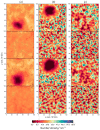Structural Phenomena in a Vesicle Membrane Obtained through an Evolution Experiment: A Study Based on MD Simulations
- PMID: 37629592
- PMCID: PMC10455627
- DOI: 10.3390/life13081735
Structural Phenomena in a Vesicle Membrane Obtained through an Evolution Experiment: A Study Based on MD Simulations
Abstract
The chemical evolution of biomolecules was clearly affected by the overall extreme environmental conditions found on Early Earth. Periodic temperature changes inside the Earth's crust may have played a role in the emergence and survival of functional peptides embedded in vesicular compartments. In this study, all-atom molecular dynamic (MD) simulations were used to elucidate the effect of temperature on the properties of functionalized vesicle membranes. A plausible prebiotic system was selected, constituted by a model membrane bilayer from an equimolar mixture of long-chain fatty acids and fatty amines, and an octapeptide, KSPFPFAA, previously identified as an optimized functional peptide in an evolution experiment. This peptide tends to form the largest spontaneous aggregates at higher temperatures, thereby enhancing the pore-formation process and the eventual transfer of essential molecules in a prebiotic scenario. The analyses also suggest that peptide-amphiphile interactions affect the structural properties of the membrane, with a significant increase in the degree of interdigitation at the lowest temperatures under study.
Keywords: molecular dynamics; origin of life; peptide aggregation.
Conflict of interest statement
The authors declare no conflict of interest.
Figures








References
-
- Kitadai N., Maruyama S. Origins of building blocks of life: A review. Geosci. Front. 2018;9:1117–1153. doi: 10.1016/j.gsf.2017.07.007. - DOI
-
- Harrison T.M. Hadean Earth. Springer; Cham, Switzerland: 2020. Could the Hadean Eon Have Been Habitable?
LinkOut - more resources
Full Text Sources

